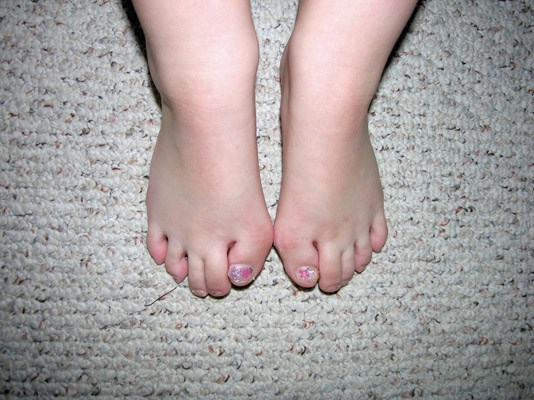At first glance, six-year-old Miranda Munro may seem rather ordinary.
She watches cartoons and argues with her mom about the volume, while negotiating the procurement of two chocolate bars. She has a mechanical hamster named Princess Buttercup, and she likes swimming and playing on the computer. Her family lives in a shady housing complex in Burnaby's Forest Grove area, and few would guess this little girl is one in two million.
When Miranda was born, she seemed perfectly normal, except for one thing: her big toes were turned inward.
"None of the doctors knew what to make of it," says her mom Karen.
Then, when Miranda was one and a half, she fell and hit her head, and her face was so swollen that her eyes were shut. Miranda would suffer more swelling, sometimes from bumps and at other times for no apparent reason.
There were blood tests, but nothing conclusive. Miranda would get more swollen bumps, apparently for no reason.
It wasn't till Miranda was two years and three months old that a geneticist finally figured it out - fibrodysplasia ossificans progressiva, or FOP for short. It's a genetic disease so rare, only one in two million are affected, and most doctors wouldn't know it if they saw it.
FOP flare-ups or physical trauma can turn muscles, tendons and ligaments to bone. Miranda's swelling was because fragments of bone were forming beneath her skin. As the disease progresses, the body becomes trapped in a skeleton. There is no known treatment or cure, and surgery tends to make things worse.
Karen was horrified to learn her daughter had FOP.
"It sounded like something out of a science fiction film. If there is no treatment or cure for this thing, by the time she is a young adult, she'll be locked in a second skeleton from head to toe."
FOP is sometimes referred to as Stone Man Syndrome, and its sufferers are called living statues. There's no other known disease like it, where one organ system turns into another. There are an estimated 3,000 cases worldwide, but only 700 have been confirmed.
For Miranda, FOP restricts her mobility. Her back is rigid, and her shoulders are almost completely locked. Her right elbow is stuck in an L-shape, and her left is also partially locked. People with FOP can live till their 80s, but the median life expectancy is 41.
Karen says her daughter doesn't realize what she's up against.
"I don't think she really grasps that it's a progressive thing that's going to limit her mobility more," she says. "We try to explain things to her in an age-appropriate way."
FOP is also one of those "orphan diseases" that afflicts so few that there's not a whole lot of research or hunt for a cure. It's is caused by a mutated gene that's involved in skeleton formation, and it can be passed on from parent to child. Miranda's mother, father and brother don't have FOP, and Karen fig-ures Miranda's case was caused by a rare genetic mutation at conception.
Like the Munros, many are looking to the University of Pennsylvania for a cure. The school of medicine there spends about $1.5 million a year to fund work by FOP researchers, who discovered the genetic mutation that causes the disease in 2006. Now, Karen is hoping for a drug to treat it. That's why the Munros are organizing a fundraising bike ride on Aug. 20 in Port Moody. About 10 family members and friends are participating, and Miranda will be riding a modified bike that makes it easier for her to cycle.
Karen hopes to raise $5,000 and get more people across Canada involved. The money will go to the Canadian FOP Network, a non-profit group dedicated to promoting awareness of the disease and support for a cure. But again, because of the rarity of FOP, the Munros are pretty much it when it comes to the organization's B.C. chapter. Karen also blogs weekly about FOP. (Go to www.friendswithfop.com.) To donate, go to www. CanadaHelps.org, click on Giving Pages and type in Karen Munro to find her fundraising page.
Still, Miranda's future is somewhat uncertain.
"If they don't come up with a medication, I just want her to be happy," Karen says.



